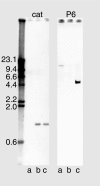Construction of a mutant and characterization of the role of the vaccine antigen P6 in outer membrane integrity of nontypeable Haemophilus influenzae
- PMID: 16926409
- PMCID: PMC1594858
- DOI: 10.1128/IAI.00692-06
Construction of a mutant and characterization of the role of the vaccine antigen P6 in outer membrane integrity of nontypeable Haemophilus influenzae
Abstract
Outer membrane protein P6 is the subject of investigation as a vaccine antigen to prevent infections caused by nontypeable Haemophilus influenzae, which causes otitis media in children and respiratory tract infections in adults with chronic lung disease. P6 induces protective immune responses in animal models and is the target of potentially protective immune responses in humans. P6 is a 16-kDa lipoprotein that shares homology with the peptidoglycan-associated lipoproteins of gram-negative bacteria and is highly conserved among strains of H. influenzae. To characterize the function of P6, an isogenic mutant was constructed by replacing the P6 gene with a chloramphenicol resistance cassette. The P6 mutant showed altered colony morphology and slower growth in vitro than that of the parent strain. By electron microscopy, the P6 mutant cells demonstrated increased size, variability in size, vesicle formation, and fragility compared to the parent cells. The P6 mutant showed hypersensitivity to selected antibiotics with different mechanisms of action, indicating increased accessibility of the agents to their targets. The P6 mutant was more sensitive to complement-mediated killing by normal human serum. Complementation of the mutation in trans completely or partially restored the phenotypes. We concluded that P6 plays a structural role in maintaining the integrity of the outer membrane by anchoring the outer membrane to the cell wall. The observation that the absence of expression of P6 is detrimental to the cell is a highly desirable feature for a vaccine antigen, supporting further investigation of P6 as a vaccine candidate for H. influenzae.
Figures






References
-
- Abe, Y., T. F. Murphy, S. Sethi, H. S. Faden, J. Dmochowski, Y. Harabuchi, and Y. M. Thanavala. 2002. Lymphocyte proliferative response to P6 of Haemophilus influenzae is associated with relative protection from exacerbations of chronic obstructive pulmonary disease. Am. J. Respir. Crit. Care Med. 165:967-971. - PubMed
-
- Aliprantis, A. O., R. B. Yang, M. R. Mark, S. Suggett, B. Devaux, J. D. Radolf, G. R. Klimpel, P. Godowski, and A. Zychlinsky. 1999. Cell activation and apoptosis by bacterial lipoproteins through Toll-like receptor-2. Science 285:736-739. - PubMed
-
- American Thoracic Society. 1995. Standards for the diagnosis and care of patients with chronic obstructive pulmonary disease. Am. J. Respir. Crit. Care Med. 152:S77-S121. - PubMed
Publication types
MeSH terms
Substances
Grants and funding
LinkOut - more resources
Full Text Sources
Other Literature Sources
Research Materials

